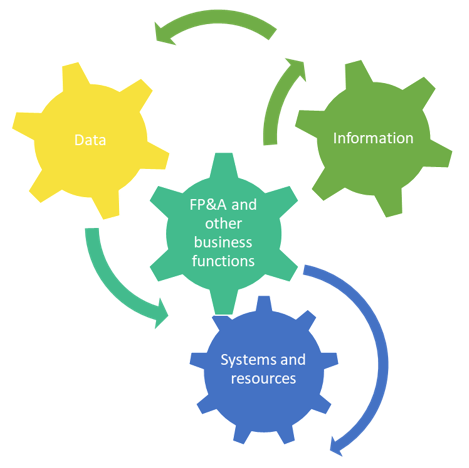How far can you go with improving your FP&A practices? This article reveals relationship between three...
 …or thoughts on the optimization of the FP&A value proposition.
…or thoughts on the optimization of the FP&A value proposition.
“If you can’t explain it to a six-year-old, you don’t understand it yourself.”
Albert Einstein
Imagine you have 3 minutes to explain to a six-year-old what FP&A is and what place it takes in a business ecosystem. Tough, isn’t it? What are things that a six-year-old would understand? For example, animals, right?
Once I came up with an analogy of a three-headed serpent. Later on, this mythical being has evolved in a new ‘species’: a four-headed dragon. This legendary serpent doesn’t live in a fairy tale though, this story is about the real business world. If you have read the first story about this being, you might remember its biggest problem: deciding which of the three heads is the master. In business it is also so often the case: there are so many different components involved, so which of them is the most important, how do they interact and how can this interaction be optimized?
FP&A delivers value to the business
Let’s start with the following two (rather philosophical) questions:
- Why FP&A does exist?
- Who are the main customers of FP&A services?
I hope that we all agree that the main customer of FP&A services is management on different organizational levels. And the key value that you deliver to them is support in decision making. That’s it. That is why FP&A exists. All of your daily tasks like budgeting, planning, forecasting, analysis, etc. focus on the delivery of the key value: supporting decision making in short-, medium-, and long-term.
Optimizing the delivery of your key value proposition
Step 1. Limit information to the required level and to the scope of the decisions to be made.
Let’s take a look at this picture. The answer to the question ‘how can I optimize FP&A value?’ lies in there.

You support decision making by providing insights into information which forms the basis for the decision making. How many reports does your department deliver to management? How much information from these reports is read and used for making decisions?
Once I heard of an assignment to optimize 11.000 reports. You might be a champion at what you do but still…Maybe it is time to go and to ask your company’s management: which information do they really need for which kind of decisions? This is the first step in the optimization of your FP&A function. Another benefit you can get here, is improving your business partnering with such stakeholders as management, company owners, regulators etc.
Step 2. Ask for data that is limited to information needs.
To satisfy your optimized information requirements you need the optimized data delivery. The action will reduce costs on data processing and storage as well as maintenance of software systems. To get make your task done, you need to develop your business partnering with business, which owns data, and with data management function, that is responsible for optimization of the whole chain of data delivery from the source to the final destination and setting up data quality framework. Building FP&A architecture together with data architects is also an example of business collaboration. As soon as you get data, it has to be processed and analysed. Especially the last part is part of FP&A duties. Which optimization can you implement here?
Step 3. Optimize FP&A business processes.
A while ago, I was at talking to a CFO of a large international company, and I remember him saying: ‘Finance is data’. These words sounded so true to me, and I think this is the real essence of what is going on in business, and FP&A in particular. Do you agree? How much of your daily tasks revolve around data? If you have managed to optimize data delivery, including improving the quality of data, now you might be spending a bit part of your time on trying to make sense of the data you have, and investigating different business scenarios. You might start experimenting with new FP&A techniques, such as driver-based modelling, rolling forecast, zero-based budgeting. Your business partnering efforts, again, focus on business stakeholders.
Step 4. Implement only those systems that fit your company’s purpose, culture and resources.
It is a very common delusion: a new system will solve old problems. No way. A new system can deliver value only when the data that is entered is clean, and when the right processes are chosen. Furthermore, a new system has to fit the purpose, culture and resources of your business. You should consider any system only as a supporting capability that enables the execution of your core tasks. Here you have a chance to build a solid partnering with IT and data management colleagues. Now data scientists also form a part of FP&A environment. So, be prepared to work together if you want to optimize your analysis techniques.
Now let’s get back to our serpent. I believe its four heads are four masters that cannot be separated from each other. Each head plays own important role in FP&A development. It is essential for them to work together towards a common goal and correspond to the company’s resources and ambitions. Only then they can conquer the world.
Subscribe to
FP&A Trends Digest

We will regularly update you on the latest trends and developments in FP&A. Take the opportunity to have articles written by finance thought leaders delivered directly to your inbox; watch compelling webinars; connect with like-minded professionals; and become a part of our global community.



